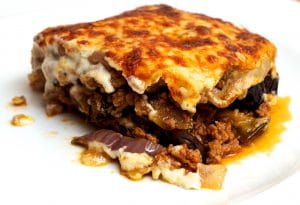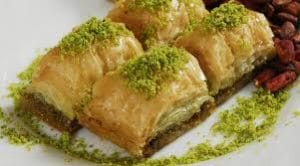Two countries, located side by side in the Mediterranean sea. They share a similar climate, the Mediterranean sun, and many of the same landscapes. With overlapping histories, they both have a shared but unique heritage, which is reflected in their cuisine.
I have visited both countries and each will forcibly claim to have invented national dishes. I have even heard that the Turks invented pizza, the delicious Pide. However, I am sure the Italians would hotly dispute this point!
To understand the similarities you need to understand the history.
One of the earliest Greek civilisations were the Cretan Minoans. The Minoans grew the first grains and made very rustic wine from native wild grapes. Although the Greeks cannot claim to have invented bread it is possible that they first thought of the oven to bake it in. Following on from bread the Greeks and Turks also began to cultivate orchards of fruit and nut trees, olive groves and kept bees for honey.
Due to its location Turkey has always been influenced by the Middle East and Asia. The silk road ran straight through Anatolia, bringing rice and sweets from Persia and shish kebabs from the travelling nomads. Thanks to it’s size and diversity Turkey remains one of the few self-sustaining countries in the world.
Many dishes are virtually the same in Greece and Turkey. They both have a delicious chicken soup made with lemon. The Turks often add yoghurt to theirs. Definitely a Turkish invention! While the Greeks add more herbs, marjoram and oregano.
Both make salads from a wide variety of fresh vegetables but the Greeks will add feta cheese the Turks will spice it up with their love of chillis.
Both enjoy stuffed vine leaves. Dolma in Turkish, dolmades in Greek. The Turkish version will often contain dried fruit from their Ottoman legacy while the Greek will contain fennel and mint.

Moussaka is another dish with claims to both nations. In Turkey, it is sautéed and served in the style of a casserole, and consumed warm or at room temperature. In Arabic countries, a variant is eaten cold. In the Balkans, the dish is layered and typically served hot. Many versions have a top layer made of milk-based sauce thickened with egg. The modern Greek version was probably formulated in the 1920s in Athens. It has three layers that are separately cooked before being combined for the final baking: a bottom layer of sliced eggplant sautéed in olive oil; a middle layer of ground lamb lightly cooked with chopped or puréed tomatoes, onion, garlic, and spices (cinnamon,allspice and black pepper, undeniably an Ottoman influence); and a top layer of Béchamel sauce. Moussaka is usually served warm, not piping hot; in Greece.
 Perhaps the most contentious issue is Baklava. Almost all people of the Middle East, Arabs, Jews, Balkans, Turks, Greeks and Armenians try to claim Baklava as their own. Because all of these regions once belonging within the Ottoman Empire it is reasonable to suggest that Baklava is an Ottoman delicacy. However, because Ottoman tends to mean Turkish the Greeks and Arabs will not be happy with this assumption. My only advice would be to eat and try everything you are offered. Smile and agree with whichever nationality is serving you but when it comes to Baklava…………. I have to confess, my heart lies with Turkey!
Perhaps the most contentious issue is Baklava. Almost all people of the Middle East, Arabs, Jews, Balkans, Turks, Greeks and Armenians try to claim Baklava as their own. Because all of these regions once belonging within the Ottoman Empire it is reasonable to suggest that Baklava is an Ottoman delicacy. However, because Ottoman tends to mean Turkish the Greeks and Arabs will not be happy with this assumption. My only advice would be to eat and try everything you are offered. Smile and agree with whichever nationality is serving you but when it comes to Baklava…………. I have to confess, my heart lies with Turkey!


Comments